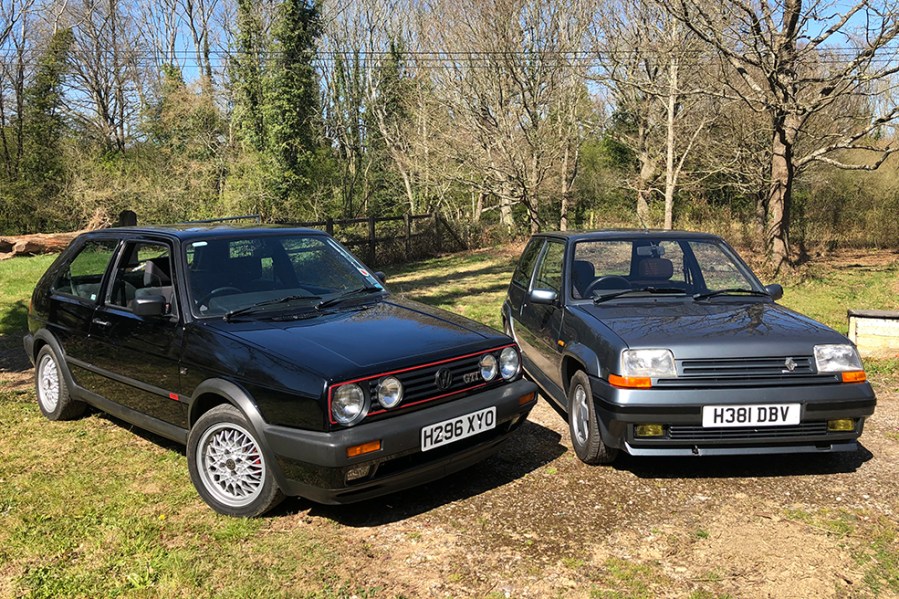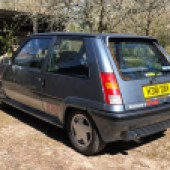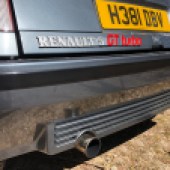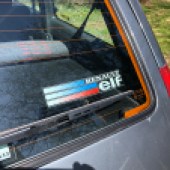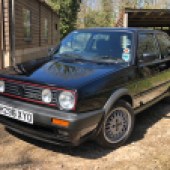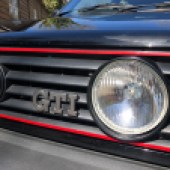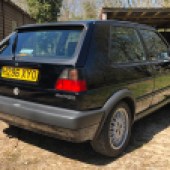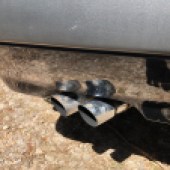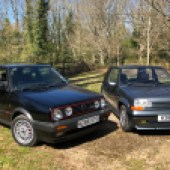The stars have aligned to make the Renault 5 GT Turbo and Mk2 Golf GTI rivals for a nostalgic hot hatch fix, but which offers the best experience?
Let’s get the elephant out of the room first of all. By 1990, the Renault 5 GT Turbo and the Volkswagen Golf GTI were not quite direct competitors. The frantic and sometimes flimsy Renault had a small carb-fed pushrod engine with a turbo strapped on, while the Golf was a more grown-up, more expensive affair with the option of five doors and an injected 1.8 motor.
And yet, with supply of 80s and 90s hot hatches outstripping demand, there’s been a real levelling up. It’s a seller’s market these days, and that means both of this cars will likely be on the radar for nostalgia-fuelled buyers. Fortunately, we were able to get hold of a pair of last-of-the-line examples to help decide between the two.
In any case, these cars have a lot more in common than is first apparent – especially if you go back to the beginning. Back in the formative years of the hot hatch, long before the term entered the mainstream, both VW and Renault were early pioneers. The Golf GTI is almost universally recognised as the daddy, but Renault got the jump on its German rival by a couple of months when it launched a hotted up version of its 5 supermini in 1976.
Known as the Alpine, the sporty 5 was fitted with a 1397cc Cléon pushrod engine with a twin-choke Weber, which despite tracing its roots back to the early ’60s, was good for 93bhp – twice that of a stock 1108cc car. Also endowed with a five-speed gearbox, the Renault could hit 60mph in 9.7 seconds and manage nearly 105mph. Exterior-wise it really looked the part, distinguishable by deep dish Fergat steel wheels or polished alloys, front fog lights and neat stripes, while inside you got smart high-back seats and a sporty steering wheel.
Despite being beaten to the first punch, however, the Golf was more advanced than the Renault. Development began with VW engineers working out of hours on a ‘Sport Golf’, raiding the VAG parts bin and fitting a 1588cc OHC engine that had been developed for the Audi 80GT. The car was later renamed the Golf GTI and fitted with Bosch K-Jetronic fuel injection instead of carbs, which not only made it good for 108bhp and a 9-second 0-60mph time, but made it turn-key reliable too. Meanwhile, the pretty Giugiaro-penned exterior was given its trademark red pinstriped grille, extended arch lips, a chin spoiler and wide steel wheels, resulting in a great-looking car that could do 110mph.
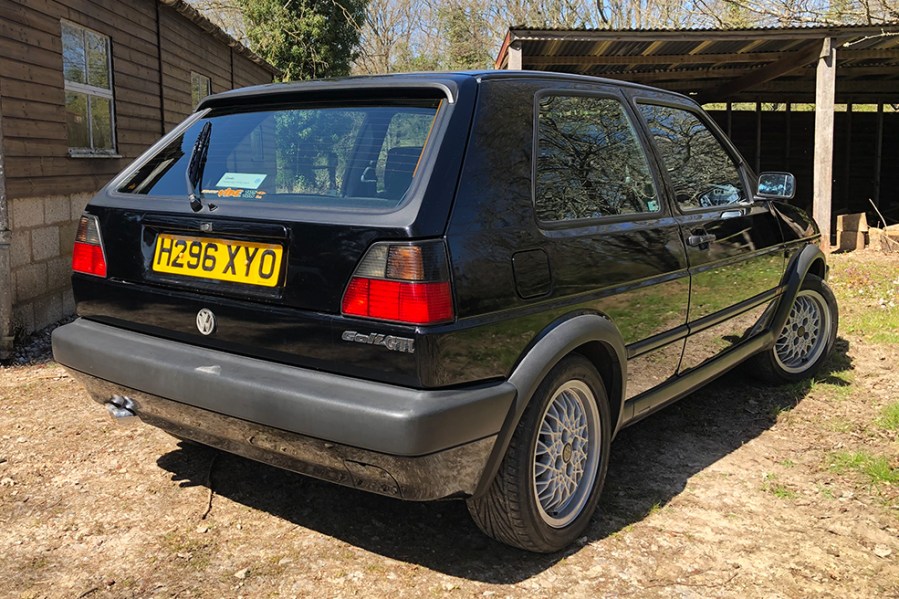
The GTI was originally sold exclusively in West Germany but in 1977 Volkswagen began importing left-hand drive versions to the UK. However, it wasn’t until 1979 that VW finally started building right-hand drive models. Once again though, it was beaten by Renault. The right-hand drive version of the Alpine was shown at the British Motor Show in 1978 and was officially on sale from April 1979 – still months before a right-hook Golf GTI arrived. It was sold in the UK as the Renault 5 Gordini because Chrysler Europe was already using the Alpine name for the UK-market version of the Simca 1307.
Development for both cars continued, to the extent that an early Mk1 GTI with its two headlights, four-speed box and metal bumpers is a quite a different beast from a late-model one with quad front lamps, alloys, a five-speed box and the larger 1781cc motor. The bigger engine only boosted power by 2bhp, but with a useful additional slug of mid-range torque.
Changes were afoot for the 5 too. Renault was at the forefront of turbo technology in Formula One in the late ’70s, debuting its 1.5-litre V6 turbo-engined RS 01 at the British Grand Prix at Silverstone in July 1977, and would filter some of that know-how down to its road cars. It launched the 160bhp homologation special mid-engined 5 Turbo in 1980, but by 1982, the Gordini version had also been turbocharged courtesy of a Garrett T3 blower. Replacing the naturally-aspirated model, it produced 110bhp and was good for 112mph. That handily made it a match for the Golf.
Volkswagen didn’t stand still though, and soon after the Golf grew up considerably. Arriving in the UK in March 1984, the new Mk2 Golf was the result of a £500m investment and boasted some far-reaching engineering changes to make it a much more complete car than the outgoing Mkl. Although the basic platform was that of the Mk1, its replacement Mk2 featured a two-inch wider track and three-inch longer wheelbase plus a bodyshell larger in all dimensions. This allowed for more interior space, and made the Golf more family-friendly.
It also made it heavier, at around 920kg compared to the Mk1’s 840kg. However, the Mk2 focused on efficiency, with details like integrated rain gutters and flush-fitting quarter lights enabling it to post a drag coefficient of just 0.34 – a significant improvement on the 0.42 of the Mk1. So while the GTI continued with the 112bhp 1781cc powerplant, it had a slightly higher top speed of 118mph rather than 114mph and got to 60mph almost half a second quicker – at least, according to the heavily-contested figures of the period.
Underneath, the chassis design used the same concept but wheel travel was increased, while the rear axle gained a kid of passive-steer in the guise of V-shaped toe-correcting bushes which allowed even more capable handling. It also stopped a lot better; the Mk1’s brakes were always an Achilles’ heel thanks to the brake master cylinder remaining on the left-hand side and being operated by a crude cross linkage. There was none of that kind of compromise for the Mk2 though, which was properly engineered for right-hand-drive, and in any case, had discs all round.
In the spring of 1985, the GTI’s versatility and shift upmarket was further emphasised by the availability of a five-door version. It was otherwise identical to the three-door except for the extra doors and standard-fit alloys, while both models gained a twin-tailpipe exhaust. A year later, the 137bhp 16-valve GTI arrived too, which was a response both to Ford’s turbocharged Escorts and the greater pace of Vauxhall/Opel’s Astra GTE with its 2-litre engine.
From here the Golf continued relatively little changed apart from a facelift in August 1987 that brought in wider grille slats and the removal of the front quarterlight windows. Then, for the 1989 model year, the GTI gained chunky colour-coded plastic bumpers which have since given these cars the nickname ‘Big Bumper’ – as exhibited by the example we see on these pages.
To continue the parallels between the pairing, the Renault 5 was also considerably updated with the arrival of the new ‘Supercinq’ model, which arrived in the UK in 1985. This was an even bigger rework than the Golf, with a completely new bodyshell styled by Marcello Gandini to retain the aesthetic of the original 5, and a platform based on that of the larger Renault 9 and 11. As with the Golf, the new body was wider and longer, with 20 per cent more glass area, more interior space and a lower drag coefficient – this time of 0.35. Another huge change was the engine position; the original 5 had a longitudinally-mounted engine, but the new cars had their engines mounted transversely, as well as the addition of MacPherson strut front suspension.
There was a new forced-induction version too, known as the 5 GT Turbo. Once again it used the ageing, carb-fed 1397cc pushrod motor, but with a smaller Garrett T2 turbocharger. Weighing a mere 850kg, the 113bhp GT Turbo was a rapid performer for the time, reaching 60 in under eight seconds on its way to a top speed of 123mph. Suspension upgrades included lowered ride height and a special ‘four bar’ torsion beam at the rear, together with anti-roll bars at both ends. You also got discs all around that were ventilated at the front. Fitted with a chunky bodykit and alloys, the 5GTT really looked the part, too.
It wasn’t without its problems, however. The car’s reputation for hot-start hissy fits was eased by a 1987 facelift that included water cooling for the Garrett T2 turbo, ignition changes to boost power to 118hp and a painted bodykit. In this guise, 125mph and a 0-60 sprint in 7.5 seconds were possible.
Both cars would depart in 1991, with the GTI replaced by the bulkier Mk3 model and the 5 GTT by the Renault Clio 16v. Both of our cars here are from the final year of production, with a black three-door Golf GTI 8-valve guise lining up alongside a Renault 5 GT Turbo in Tungsten Grey. They are extremely well kept examples belonging to the same owner, Ben De Grouchy, and as such they offer an excellent opportunity to sample both cars on a level playing field.
Exterior-wise, it’s the Renault that shouts loudest and evokes the greatest degree of nostalgia. That’s in part due to its bodykit with its squared-off arch extensions and bold graphics, but also due to its rarity. Fewer than 300 are thought to remain on our roads, with many modified beyond recognition with Max Power-era bodykits and Ali-G style letterbox exhausts. To see one in its original form on its tiny 13-inch wheels is both refreshing and pleasing.
The big-bumpered Golf wears sporty 15-inch BBS alloys and boasts trademark red detailing around the grille and on its rubbing strips, but it was never as exciting to look at in period as some of its rivals, and is still familiar enough to go under the radar today. On the whole, the Golf boasts a more mature, premium appearance that can blend in and do discreet in a way the Renault can’t. It’s always been a more classless car than the Renault, suitable for city slickers and families alike, while the 5 hasn’t managed to completely shake its boy-racer image.
The more mature feel of the Golf continues inside. At around 14 inches longer and four inches wider, the VW is naturally bigger and more practical than the Renault. It also lives up to the German efficiency stereotype in that it feels solid and well-built without being too brave or exciting – the dimpled golf-ball inspired gearknob is about as thrilling as it gets.
Climb in the Renault though, and things reverse. You’re immediately looking at funky orange on black dials through a much sportier Momo-style three-spoke steering wheel, while the seats are softer but more sculpted to wedge the driver in place.
The quirky shelf-shaped dash is also more adventurous in its design, but it’s immediately apparent that the quality is not on the same level. While the Golf’s soft-touch trim is strong and sturdy, the 5’s is made of plastic more akin to a microwave meal tray. Squeaks and rattles are just par for the course for the 5, with Ben informing us that some trim parts have become unobtainable. A glance under the bonnet also illustrates the difference – the Golf is clean and simple, while the turbo’d Renault is myriad of pipes and clutter.
The flimsiness-meets-turbocharged nature of the Renault may lead folk to believe it’ll be completely unhinged on the road, but this example was a pleasant surprise. There’s more turbo lag than you’d find from a modern Ecoboost engine for example, but this only adds to the character and it’s not exactly an on-off switch. Remarkably, the boost is delivered without too much torque steer, either. OK, the little Renault is not fast by today’s standards but there’s more than enough grunt there to keep you entertained and it feels quicker than the figures suggest.
Besides, the engine is just a facilitator anyway, for it’s the car’s chassis that makes it so fun. The unassisted steering is a joy, being brilliantly weighted and offering plenty of feedback. The turn-in is also impressive, and while not wishing to push this cherished example too hard, it felt a lot more predictable to drive hard than a Peugeot 205 GTI with its notorious lift-off oversteer. It’s a live-wire that seems to thrive on maximum attack but can be tootled around easy enough off-boost, too.
Criticisms? Well the Renault 5 GT Turbo does give off the occasional whiff of smoke when hot starting, suggesting that it will be fun for a while, but won’t do it for 200,000 miles without issue like the Golf probably would. Its light, flimsy feel also shows how far cars have come in three decades, and with its thin metal and minimal crash protection you certainly wouldn’t want to hit anything in it.
Predictably, the fuel-injected Golf starts on the first turn of the key, with no grumbles even when hot. Out on the road though, it becomes apparent that the engine is not as exciting as the Renault’s in the way it delivers its power. It’s an entirely linear power delivery so you just keep accelerating, but there’s no shove in the back or sense of theatre like you get with the Renault 5 GT Turbo.
The trade-off is the flexibility you’d expect of a larger capacity engine, being happy in fourth or fifth gear at 30mph or so but still able to accelerate cleanly. A 16-valve Golf would no doubt nudge the excitement up, but the eight-valve has a more useable spread of torque. Besides, back in 1990 the 16-valve was over £4000 more expensive than the Renault, while the 8-valve carried a more modest premium of around £1100.
All things considered, the eight-valve is still unmistakably an excellent hot hatch. It’s superbly stable when pushing on, with sharp but safe and predictable handling. The experience is a little more sanitised then the Renault but get it on the boil and you feel brilliantly connected to the Golf. It’s still hugely entertaining, and there’s the bonus of being able to thrash it all day long. The Renault, on the other hand, requires you – and it – to be in the right mood. And as this is a later Golf with power steering, it’s also a lot easier to manoeuvre at low speeds, whereas the Renault can become tiresome.
Volkswagen Golf GTI Mk2 vs Renault 5 GT Turbo: our verdict
The whole appeal of a hot hatch has always been about mixing two personalities; blending practicality with the kind of sporting ability usually the preserve of much more specialist machinery. The decision between the two depends on how far along the sliding scale between sanity and madness you want to be.
The Golf undoubtedly does a better job in balancing these parameters, and as such, is the more holistic choice. It’s easier to live with, more reliable, better built, longer lasting, safer and easier to own. The relative rarity of the Renault also means that an equivalent Golf will be a couple of grand cheaper, too. If you want to use one of these cars everyday, then the Golf is surely the one to have.
The likelihood is that you won’t be doing that these days, which tends to leave the Golf a little shorn of what it does best. And while it doubtless is a joy to own, it’s a little too clinical to take you to the heights that the flawed but fun Renault occasionally can. If you’re not going to drive it everyday, then why not have a classic that can turn things up to 11? The Renault is clearly not the sensible choice and if you’re not in the right frame of mind its rattling trim may well drive you mad, but its foibles are easier to forgive if you’re not relying on it for the commute.
In days gone by, it would have been easy to conclude by saying that the Renault is the car you want to drive and the Golf is the one to own, but these days it’s more dependent on your circumstances and levels of bravery. The VW has long been hot hatch royalty, but the fact that the Renault 5 GT Turbo has us thinking twice is testament to how well Renault did to challenge the mighty GTI with just a 1400 pushrod motor and a carburettor.

